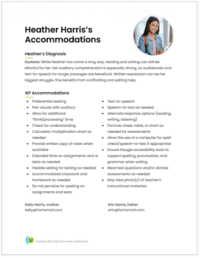IEP and 504 Accommodations for Specific Learning Disabilities (SLD)s
Accommodations for dyslexia
Students with dyslexia have difficulties with word recognition, spelling, and decoding; as a result, they typically struggle with learning how to read and write. Math can be more difficult as well when it involves reading multistep directions, decoding unfamiliar words, sequencing information, and comprehending instructions.
Here are some accommodations commonly included in an IEP or 504 plan for students with dyslexia:
Alternative means to access text, such as:
- Access to text to speech (TTS)
- Utilization of a reader
- Audiobooks and digital books that work with screenreaders
- Provide alternative books with similar concepts, but at an easier reading level
- Use both oral and printed directions
- Access to test questions and answer choices read aloud
- For math, read and explain story problems or break problems into smaller steps
Alternative means to written expression, such as:
- Speech to text (STT) apps
- Utilization of a scribe
- Access to technology for dictation or audio recorder
- AI notetaking app
- Access to teacher notes
- Allow spellcheck software
- Allow word prediction software
- No penalty for spelling errors
Provide alternatives to reading aloud in front of the class
Support for emerging reader:
- Shorten spelling tests to focus on mastering the most decodable words
- Reading chunked into smaller sections
- Additional time for assignments, especially if reading is required
- Give page numbers to help the student find answers
- Extended time on tests
Executive functioning supports
- Use of mnemonic devices
- Graphic organizers and sentence starters
- Highlight key words in directions
- Check progress and provide feedback often in the first few minutes of each assignment
- Introduce an overview of long-term assignments so that the student knows what is expected and when it is due
- Provide structured assignments with lists for the student to cross off when finished
- Break long-term assignments into small, sequential steps with daily monitoring and frequent grading
- Masking (blocking or whiting out) unnecessary content (such as navigational buttons, menu, additional questions, etc.) so that the student can focus on tests, classwork, and homework one step at a time
- Provide organizers for lockers/desk
- Allow a specified amount of extra time to turn in homework without penalty
- Allow to take photos of the classroom board and/or homework requirements
- Agenda check with a daily reminder to track assignments due
Reduce visual distractions in the classroom/learning environment
- Front-of-the-room seating
- Brain breaks
- Alternate testing environments
Dyslexia-friendly fonts such as Dyslexie
Allow student alternative means of engagement and expression that utilize strengths in spatial awareness such as drawing, maps, and charts
To learn more about supporting kids with dyslexia in school, such as recommended reading programs, check out our full article Dyslexia 101. You can find more reading supports in our article Reading Curricula, Tech, Apps, and More.
Accommodations for dysgraphia
Students with dysgraphia struggle with handwriting because of changes in their brain that affect their fine motor skills. Here are some common dysgraphia accommodations that could be included in a child’s IEP or 504 plan to help them succeed in school:
Alternative means to written expression, such as:
- Permission to type assignments instead of handwriting them
- Access to apps that convert worksheets to digital
- Speech to text (STT) apps
- Utilization of a scribe
- Access to technology for dictation or audio recorder
- Permission to audio record class lessons
- Use of AI notetaking app
- Access to teacher notes
- Lesson outlines and/or copies of classroom learning materials to help with note-taking
- Allow spell check software
- Allow word prediction software
- Allow the student to take a picture of homework assignments on the board instead of copying them down by hand
- Alternatives to handwritten responses like a video or verbal presentation
- Extra time for assignments involving handwriting
- Adaptation of testing formats to require less handwriting (like multiple-choice and fill-in-the-blank questions)
Avoid asking student to write for group or in front of other students
Use of writing aides and supports
- Spacing paper or graph paper to help improve handwriting legibility
- Paper with raised lines
- Graphic organizers (paper and digital)
- Pencil/pen grips
- Slant boards
- Thicker writing instrument, such as marker instead of pencil
- Exemption from writing in cursive
Extra time for testing involving handwriting
Allowing the student to test in a quiet room
Provision of information needed to start writing assignments early
Provide alternatives to drawing and fine motor tasks
In addition to accommodations, services for dysgraphia can include structured literacy programs, occupational therapy, handwriting and typing programs, and multisensory teaching techniques. See our full article Dysgraphia 101 for more ways to support kids with dysgraphia at school and at home. Assistive Technology (AT) for Writing also provides more ideas for tools to support them.
Accommodations for dyscalculia
Students with dyscalculia aren't just "bad at math" — neurological differences make it harder for them to process numbers and math information. Anxiety surrounding math can cause problems in the classroom as well. Here are some common IEP and 504 accommodations for students with dyscalculia:
Not calling on the student to answer math questions in class unexpectedly
Allowing the student to take pictures of note materials so they don’t have to copy them down
Extra time to complete in-class and homework assignments
Option to take math tests in a quiet room
Lesson outlines and previews before class starts
Assistive technologies like calculators, graph paper, graphing tools, math notation tools, and graphic organizers for math
Use of visuals and manipulatives such as numberline, 100s chart, multiplication chart, counters, formula chart
Circle math computation signs
Option to write answers directly on the test paper instead of having to fill out a scantron
Provide fewer problems on a worksheet (for example, 4 to 6 problems per page rather than 20 or 30, but keep the same total number of problems)
Use enlarged graph paper to help the student keep numbers in columns
Read and explain story problems or break problems into smaller steps
Use pictures or graphics
Fewer problems of the same difficulty
Other interventions could include the use of Cuisenaire rods, number tracks, and number cards; behavioral therapy for mental health issues caused by anxiety surrounding math; multisensory instruction (like asking a student to solve a problem using a digital dance mat); educational therapy; or computerized intervention programs that gamify the learning process. Check out our full article Dyscalculia 101 for more ways to support a student with dyscalculia. Math Curriculum Materials, Tech, Apps, and More has plenty of ideas for assistive technology that can be incorporated into the classroom to help with math learning.
Obtain specific learning disability (SLD) supports for my child at school
Looking for an easy way to keep your child's teachers up to date on their accommodations in class? Undivided members have access to a one-sheet accommodations template that your child can keep in their binder or give to their teacher as a reference.
Join for free
Save your favorite resources and access a custom Roadmap.
Get StartedAuthor



